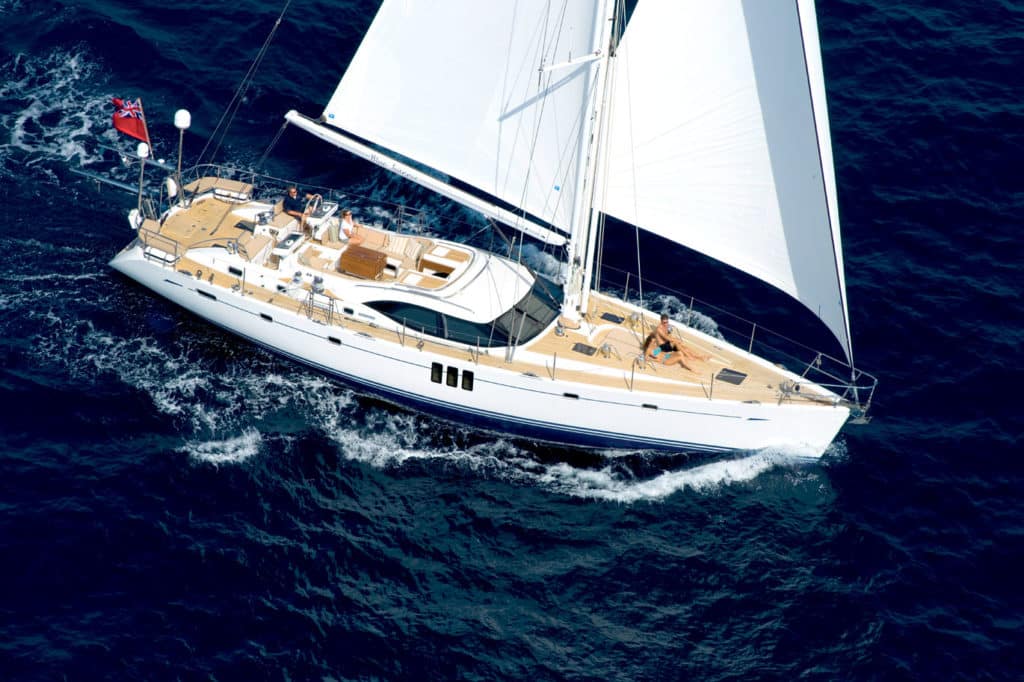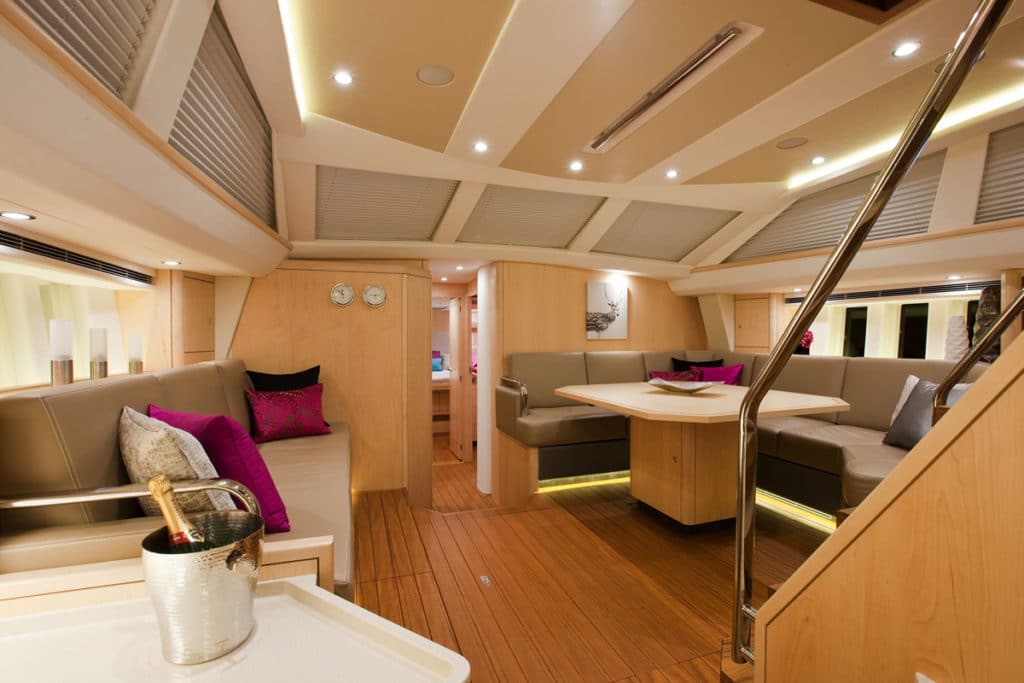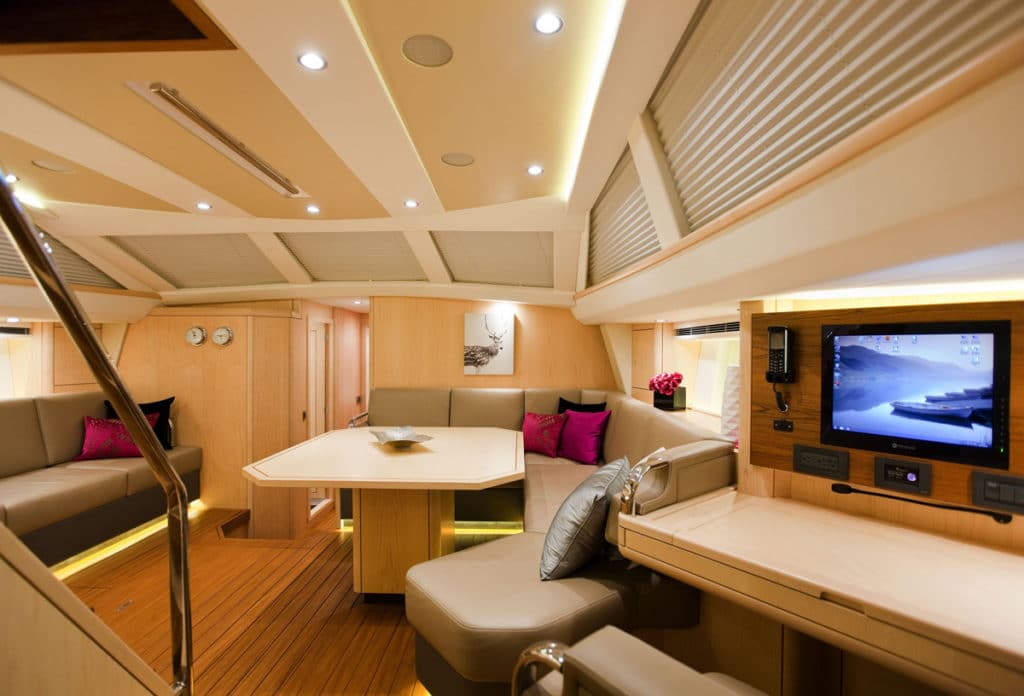
With a seven-figure price tag, the British-built Oyster 625 Deck Saloon—the deserved winner of a prestigious 2012 European Yacht of the Year Award—should easily have been the most impressive boat at the 2012 Miami Boat Show, and it was. By any standard, however, this purposeful 62-footer is a remarkable, state-of-the-art example of contemporary yacht design and construction.
Where to begin? Let’s start with the looks. It’s probably redundant to say this is a “big” 62-foot yacht, but there’s an awful lot going on here. Over the years, designer Rob Humphreys has crafted a consistent style throughout the Oyster line, and the brand pedigree is evident in the 625, with some neat tweaks. Aesthetics, naturally, are a highly subjective matter, but I found this Oyster particularly striking.
In profile, the tapered foredeck rises subtly to flow directly into the sloping leading edge of the wraparound coachroof window, a pronounced feature that facilitates and defines this deck-saloon configuration. Directly beneath the cabin top amidships is a trio of vertical “seascape” windows, an Oyster first, that provide the hull with a distinctive focal point while injecting plenty of natural light through the spacious main cabin; in tandem with the deck-saloon “skylight,” they offer stunning exterior views to those seated therein.
The gentle sheer line bridges the span between the slight overhang of the stem and the steeper angle of the reverse transom. There are essentially two cockpits, one leading directly from the companionway, a large and dedicated space for lounging, entertaining, and sailhandling; and a second, more compact one just abaft, with a pair of helm stations replete with all instrumentation (including the controls for the electric winches) atop stout pedestals.
The composite construction is high-tech and first-class, incorporating a hull laminate comprised of E-glass, Kevlar, and carbon fiber; a foam core is utilized in the vacuum-bagged topsides sections, and balsa is employed in the deck structure. Three different keel configurations are available, including a fixed shoal-draft option and a dedicated, optional centerboard arrangement as well as the standard, 9-foot-2-inch high-performance bulb foil that was affixed to our test boat. The standard fractional sloop rig comes with a traditional mainsail with full battens, but our test model was set up with the optional triple-spreader cutter rig with an in-mast furling main and double headsails.


Down below, there are, again, a couple of accommodations plans from which to choose, the main difference being in the forepeak arrangement: The standard boat has a massive locker forward, accessed through a watertight door. Or one can opt for “crew quarters” in the same space with a pair of berths and a vanity.
Otherwise, the layouts are identical, with an impressive master stateroom and attached head all the way aft; a two-bunk private cabin and a straight-line galley, to port and starboard, respectively, of the engine room, which houses a 180-horsepower Volvo; the impressive central saloon, with a huge table that, when unfolded, encompasses the entire floor space from the straight-line settee to port to its L-shaped counterpart, to starboard; and another set of private cabins, and two heads, forward of the mast. The furnishings are sumptuous, the attention to detail incredible, the fit and finish to the highest order.
All that said, where the 625 truly came to life was under sail. Outside Government Cut, in a true breeze fluctuating between 8 and 14 knots and sailing on a close reach under full main and staysail alone, the boat made an effortless 7.4 to 7.8 knots. Swapping the staysail for the genoa, speed increased to a comfortable 8.5 to 8.8 knots. As the wind accelerated into the low teens, the Oyster, cracked off to a beam reach, topped off at 9.1 knots.
Had it been up to me, we would’ve kept on trucking, straight to the Bahamas. But there were other boats to sail on our trip to Miami.
Read Andrew Burton’s review of the fully-automated Oyster 62 here.
View photos of the Oyster 46 here.








